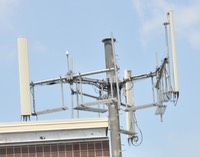My research expertise is in the field of wireless communications, with the objective of designing, analyzing, and optimizing advanced transmission technologies for future wireless networks.
Interference Analysis
The performance of modern communication systems is limited by interference, fading, and noise, all of which can be modeled as random processes. A key source of randomness in the interference is the random location and activity of the interfering transmitters. In collaboration with Dr. Don Torrieri [J24], we have developed a performance analysis for systems subject to Nakagami fading (a general type of fading distribution) and arbitrarily placed interferers, and draw parallels between this work and interference analysis based on stochastic geometry. This analytical framework is described in my presentation at Clemson University. We have used this framework to optimize and characterize the performance of ad hoc networks using frequency hopping [C73, C77] or guard zones [J25], multihop routing [C81], the cellular uplink [J26], the cellular downlink [C75, C82]. A key theme in this work is the imposition of a constrained spatial model; i.e., a model that requires a minimum separation between interferers.
Computational Communication Theory
Thanks to the availability of cheap cloud computing, it is now practical to use massive computational power to design better communication systems and solve problems related to communication theory. In the WCRL, we have a 396-core cluster computer to support our research in the areas of interference analysis, cooperative communications, and efficient coded-modulation. The computing environment is described in my plenary at the 2012 Australian Communication Theory Workshop (held in Wellington, New Zealand). These resources were funded by the NSF CRI program, and are available for other research groups that are also working on these topics. We have developed a web-interface so that you can run CML simulations remotely on our cluster. Several WVU courses, including Wireless Networking, Coding Theory, and Communication Theory, use the computing cluster to run student projects. In addition to running simulations, the cluster is used to run optimization algorithms including genetic algorithms, which are especially promising for solving hard design problems. We have used genetic algorithms to design efficient space-time codes [J19] and efficient bit-interleaved coded modulation schemes [C56].
Efficient Coded-Modulation
Modern data transmission systems combine capacity-approaching error control codes with spectrally efficient modulation to achieve a desirable tradeoff between energy- and bandwidth-efficiency. In collaboration with Dr. Xingyu Xiang [J23], we have developed a coded-modulation system that is particularly well suited for satellite channels. The system, described in my presentation at Georgia Tech, combines APSK modulation, constellation shaping, optimized LDPC codes, and iterative processing to achieve a gain of over 1 dB compared to the DVB-S2 standard. In collaboration with Dr. Don Torrieri, Dr. Shi Cheng, and Dr. Rohit Seshadri, we have developed coherent [J18], noncoherent [J13], differential [J14], and multi-symbol [J20] receivers and code designs for coded continuous-phase modulation (CPM). A key contribution in this work is the use of information theory to jointly optimize the coding and modulation parameters for the particular channel and receiver. Other issues of interest include noncoherent modulation and receiver design for the two-way relay channel [J22], the effect of finite block lengths [C57], and the constellation labeling problem [J17]. To assure that the results are reproducible, we have released the software used by this research as an open source library --- the Coded Modulation Library (CML). CML contains implementations of many common coding and modulation schemes, including those used by the LTE, WiMAX, and DVB-S2 standards. Among my presentations, you can find several tutorials on modern error correcting codes, including LDPC codes and the codes used in the IEEE 802.16e WiMAX standard. I still maintain a web page on turbo codes, which was one of the first web pages devoted to turbo codes.
Cooperative Communications
The basic idea behind cooperative communications is to allow groups of radios to collaborate in the transmission of data. This can be thought of as creating a virtual antenna array, whereby each terminal donates its own antenna or antennas to form a large array comprised of many antennas. See the presentation given at Hughes Network Systems. We have developed a hybrid-ARQ-based approach to cooperative diversity [J8, J11], whereby the ARQ retransmissions could come from a relay rather than from the original transmitter. In [J12], we have investigated asynchronous cooperative diversity systems; i.e., systems that are tolerant of a relative delay among cooperative transmissions. In [B3], we give a tutorial introduction to distributed space-time codes. More recently, I have been considering cooperative cellular systems. In our 2013 Globecom paper [C82], we consider a Coordinated Multipoint (CoMP) system that combines the downlink transmissions from multiple base stations. This work builds on our earlier work [J40, C5] involving the combination of uplink transmissions across multiple base stations.
Research Awards
I have been recognized as an Outstanding Researcher by the College of Engineering and Mineral Resources on three occasions: 2001, 2002, and 2009.
